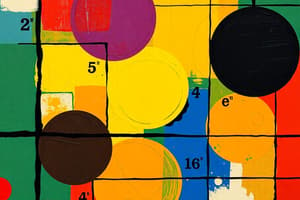Podcast
Questions and Answers
Which mathematical operation is physically meaningful for two different dimensional physical quantities A and B?
Which mathematical operation is physically meaningful for two different dimensional physical quantities A and B?
- AB
- None of these (correct)
- A - B
- A + B
Which combination of the dimensionally different physical quantities P, Q, R can never result in a meaningful quantity?
Which combination of the dimensionally different physical quantities P, Q, R can never result in a meaningful quantity?
- P Q - R
- P Q / R
- P - Q / R (correct)
- P R - Q^2 / Q R
Which group of physical quantities can be categorized as fundamental physical quantities?
Which group of physical quantities can be categorized as fundamental physical quantities?
- Displacement, time, velocity (correct)
- Mass, momentum, time, velocity
- Force, mass, acceleration
- Time, force, velocity
What is the unit represented by Newton/metre^2?
What is the unit represented by Newton/metre^2?
What does a light year measure?
What does a light year measure?
Flashcards are hidden until you start studying
Study Notes
Dimensionally Different Physical Quantities
- Physical quantities with different dimensions cannot be added or subtracted.
- Multiplication and division between dimensionally different quantities are permissible as long as the resulting expression has a meaningful physical interpretation.
Meaningful Quantity Combinations
- A meaningful quantity results when the combination of dimensions of its constituent physical quantities matches the dimensions of a known physical quantity.
- Quantities with incompatible dimensions cannot be combined to produce a meaningful quantity.
Fundamental Physical Quantities
- Fundamental physical quantities form the basis of all other physical quantities.
- They are independent and cannot be expressed in terms of each other
- Examples include mass, length, time, temperature, and electric current.
Units of Measurement
- Newton per square meter (N/m²) is the unit of pressure.
- Light year is a unit of distance, representing the distance light travels in one year.
- The CGS system uses centimeters, grams, and seconds as its fundamental units.
- The MKS system uses meters, kilograms, and seconds as its fundamental units.
Density Conversion
- Density can be converted between different unit systems by considering the conversion factors for mass and volume.
Physical Quantity Magnitude
- The magnitude of a physical quantity depends on the system of units used for measurement.
- It is independent of the method of measurement used.
Angular Velocity
- Radians per second (rad/s) is the unit of angular velocity, representing the rate of change of angular displacement over time.
Studying That Suits You
Use AI to generate personalized quizzes and flashcards to suit your learning preferences.




